Australian Retail Landscape Analysis
VerifiedAdded on 2020/03/23
|17
|4162
|70
AI Summary
This assignment delves into the competitive landscape of the Australian retail sector. It requires a comparative analysis of prominent players such as Coles, Woolworths, and Wesfarmers, focusing on their financial performance, market share dynamics, and strategies for sustainability. Students must utilize publicly available data and reports to evaluate key performance indicators, assess industry trends, and provide insights into the factors shaping the future of Australian retail.
Contribute Materials
Your contribution can guide someone’s learning journey. Share your
documents today.
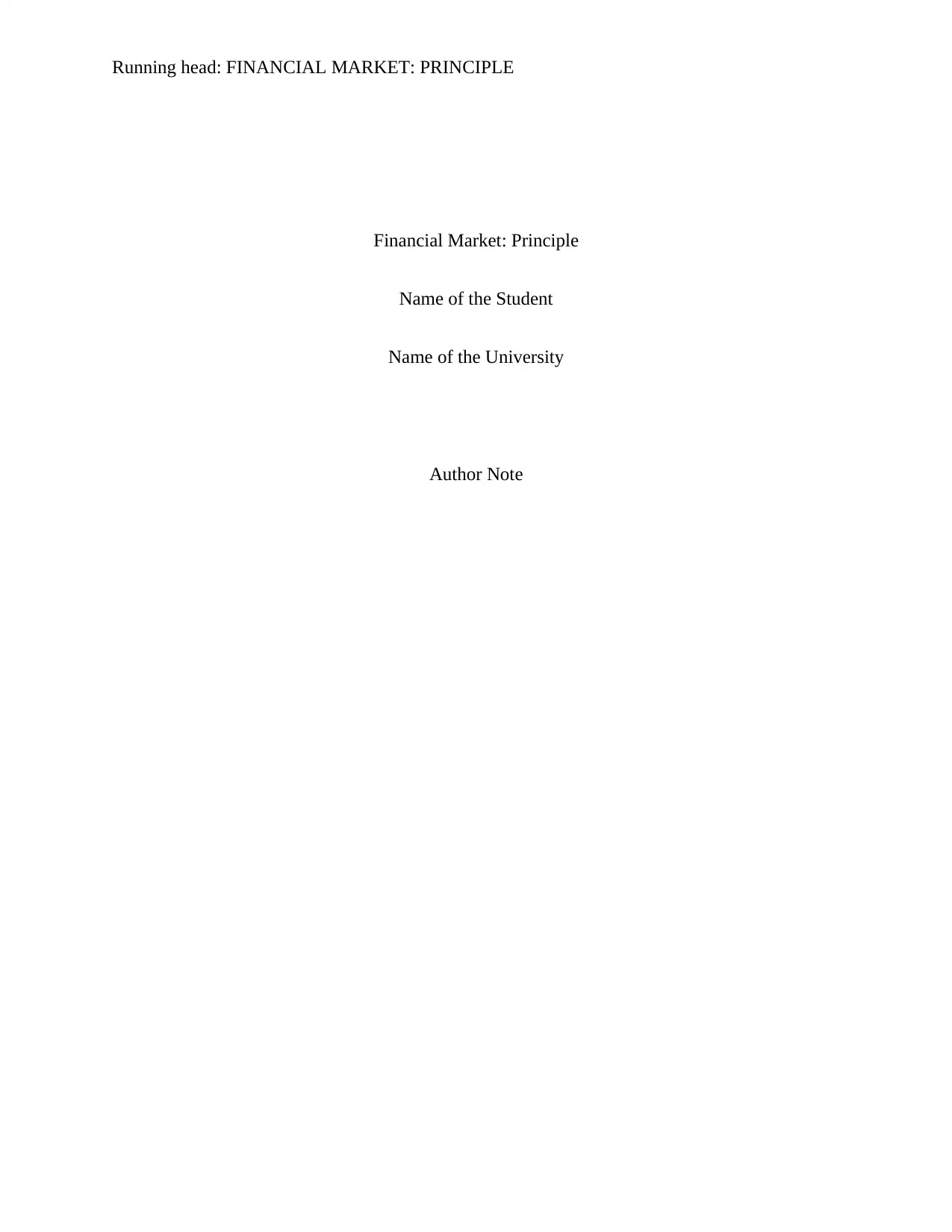
Running head: FINANCIAL MARKET: PRINCIPLE
Financial Market: Principle
Name of the Student
Name of the University
Author Note
Financial Market: Principle
Name of the Student
Name of the University
Author Note
Secure Best Marks with AI Grader
Need help grading? Try our AI Grader for instant feedback on your assignments.

Introduction:
The performance of any commercial enterprise or an industry can be evaluated with the
help of the top down analysis or the bottom up analysis, taking into account the broader
perspective and from the point of view of company. The top down mechanism includes the
breaking down of a system into its sub-components such that an insight about the sub-systems
can be attained using backward calculations. The approach includes specifying and designing of
an overview of the concerned organization (Petty et al. 2015). The component systems of a
construct, under this approach are broken down to smaller sub-systems till the basic elements of
the system are reached. Therefore, this approach starts with the system as a whole and breaks it
down to parts and sub-parts in order to get a detailed insight about the activities of the enterprise.
The report conducts these two analysis on two of the retail giants operating in the Australian
supermarket and retail grocery industry, the names being Wesfarmers and Woolworths (Heinrich
2012).
Top down Approach:
It is necessary to take into account the overall economic scenario of Australia in order to
analyze the performances of the above-mentioned retail giants. Australia, being one of the
leading economies in the global scenario, has been performing consistently well in more or less
all the economic indicators and has shown a persisting economic growth for the last 26 years.
The country being one of the primary mixed economies in the world, is known for the stability in
The performance of any commercial enterprise or an industry can be evaluated with the
help of the top down analysis or the bottom up analysis, taking into account the broader
perspective and from the point of view of company. The top down mechanism includes the
breaking down of a system into its sub-components such that an insight about the sub-systems
can be attained using backward calculations. The approach includes specifying and designing of
an overview of the concerned organization (Petty et al. 2015). The component systems of a
construct, under this approach are broken down to smaller sub-systems till the basic elements of
the system are reached. Therefore, this approach starts with the system as a whole and breaks it
down to parts and sub-parts in order to get a detailed insight about the activities of the enterprise.
The report conducts these two analysis on two of the retail giants operating in the Australian
supermarket and retail grocery industry, the names being Wesfarmers and Woolworths (Heinrich
2012).
Top down Approach:
It is necessary to take into account the overall economic scenario of Australia in order to
analyze the performances of the above-mentioned retail giants. Australia, being one of the
leading economies in the global scenario, has been performing consistently well in more or less
all the economic indicators and has shown a persisting economic growth for the last 26 years.
The country being one of the primary mixed economies in the world, is known for the stability in
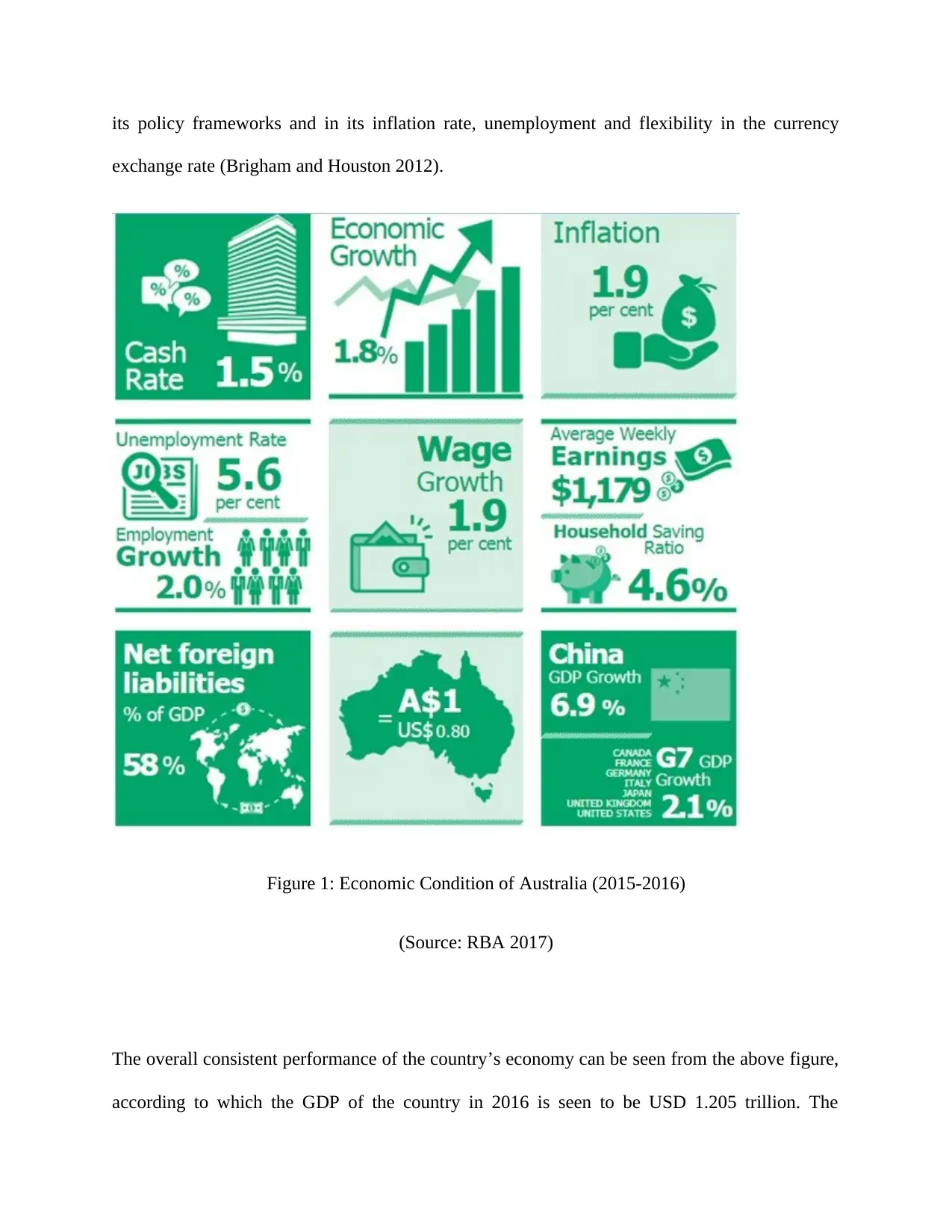
its policy frameworks and in its inflation rate, unemployment and flexibility in the currency
exchange rate (Brigham and Houston 2012).
Figure 1: Economic Condition of Australia (2015-2016)
(Source: RBA 2017)
The overall consistent performance of the country’s economy can be seen from the above figure,
according to which the GDP of the country in 2016 is seen to be USD 1.205 trillion. The
exchange rate (Brigham and Houston 2012).
Figure 1: Economic Condition of Australia (2015-2016)
(Source: RBA 2017)
The overall consistent performance of the country’s economy can be seen from the above figure,
according to which the GDP of the country in 2016 is seen to be USD 1.205 trillion. The

inflation prevailing in the economy is also found to be moderate (1.9%). The rate of
unemployment though shows an above moderate growth (5.6%), however, the employment is
also seen to be growing at a 2% rate. In a generalized scenario, the overall economic growth of
the country is seen to be 1.8%. Along with the stability in the economic growth, the country is
also experiencing a high population growth, much of which can be attributed to the migration of
job seekers and other from all parts of the world (Source: RBA 2017).
This, taken together with the economic growth, creates a huge aggregate demand, which
in turn, creates scope of increasing supply and overall productivity, thereby asserting the
presence of opportunities of expansion and growth of the retail industries which includes the
grocery retail and the supermarkets also. With the advent of globalization, international trade has
also expanded a lot in the last few decades, which clubbed with the liberal trading strategies of
the country has played a crucial role in the growth of the economy. Along with this the stable
and low inflation statistics and the increasing employment generation also helps in raising the
standard of living of the people by improving their purchasing power, which in turn increases the
demand in the economy (Plumb, Kent and Bishop 2013).
The flexible exchange rates in the country also facilitates trade and has helped in keeping
the economy floating at the times of severe crisis like that of the Global Financial Crisis which
occurred in 2007-2008. The Reserve Bank of Australia manipulated the exchange rate according
to the export import demands of the country in order to make the economy more competent in
the global commerce scenario. The economy enjoys high demand in domestic as well as in
international markets, which in turn facilitates the industrial prosperity of the country (Huang,
Zhou and Zhu 2012).
unemployment though shows an above moderate growth (5.6%), however, the employment is
also seen to be growing at a 2% rate. In a generalized scenario, the overall economic growth of
the country is seen to be 1.8%. Along with the stability in the economic growth, the country is
also experiencing a high population growth, much of which can be attributed to the migration of
job seekers and other from all parts of the world (Source: RBA 2017).
This, taken together with the economic growth, creates a huge aggregate demand, which
in turn, creates scope of increasing supply and overall productivity, thereby asserting the
presence of opportunities of expansion and growth of the retail industries which includes the
grocery retail and the supermarkets also. With the advent of globalization, international trade has
also expanded a lot in the last few decades, which clubbed with the liberal trading strategies of
the country has played a crucial role in the growth of the economy. Along with this the stable
and low inflation statistics and the increasing employment generation also helps in raising the
standard of living of the people by improving their purchasing power, which in turn increases the
demand in the economy (Plumb, Kent and Bishop 2013).
The flexible exchange rates in the country also facilitates trade and has helped in keeping
the economy floating at the times of severe crisis like that of the Global Financial Crisis which
occurred in 2007-2008. The Reserve Bank of Australia manipulated the exchange rate according
to the export import demands of the country in order to make the economy more competent in
the global commerce scenario. The economy enjoys high demand in domestic as well as in
international markets, which in turn facilitates the industrial prosperity of the country (Huang,
Zhou and Zhu 2012).
Paraphrase This Document
Need a fresh take? Get an instant paraphrase of this document with our AI Paraphraser
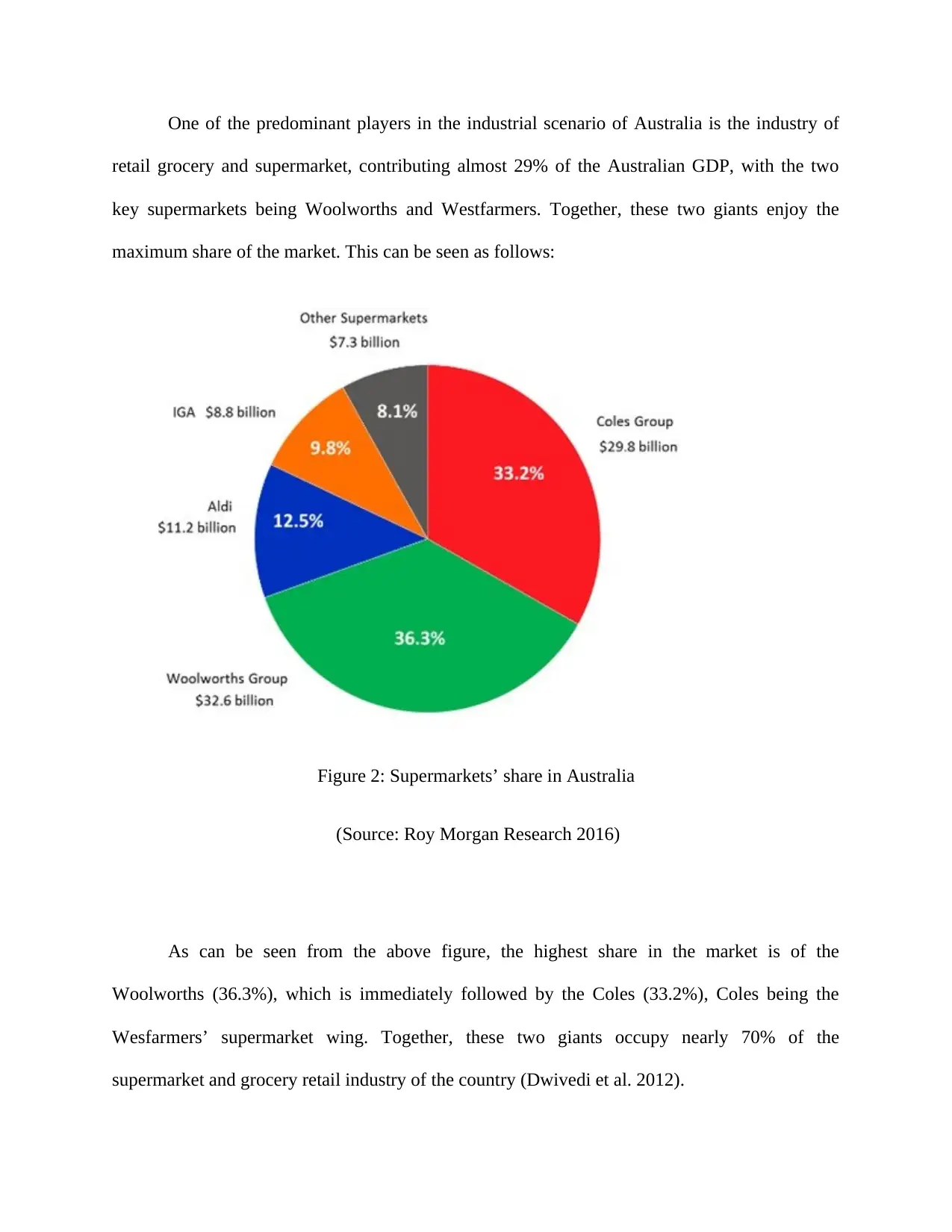
One of the predominant players in the industrial scenario of Australia is the industry of
retail grocery and supermarket, contributing almost 29% of the Australian GDP, with the two
key supermarkets being Woolworths and Westfarmers. Together, these two giants enjoy the
maximum share of the market. This can be seen as follows:
Figure 2: Supermarkets’ share in Australia
(Source: Roy Morgan Research 2016)
As can be seen from the above figure, the highest share in the market is of the
Woolworths (36.3%), which is immediately followed by the Coles (33.2%), Coles being the
Wesfarmers’ supermarket wing. Together, these two giants occupy nearly 70% of the
supermarket and grocery retail industry of the country (Dwivedi et al. 2012).
retail grocery and supermarket, contributing almost 29% of the Australian GDP, with the two
key supermarkets being Woolworths and Westfarmers. Together, these two giants enjoy the
maximum share of the market. This can be seen as follows:
Figure 2: Supermarkets’ share in Australia
(Source: Roy Morgan Research 2016)
As can be seen from the above figure, the highest share in the market is of the
Woolworths (36.3%), which is immediately followed by the Coles (33.2%), Coles being the
Wesfarmers’ supermarket wing. Together, these two giants occupy nearly 70% of the
supermarket and grocery retail industry of the country (Dwivedi et al. 2012).
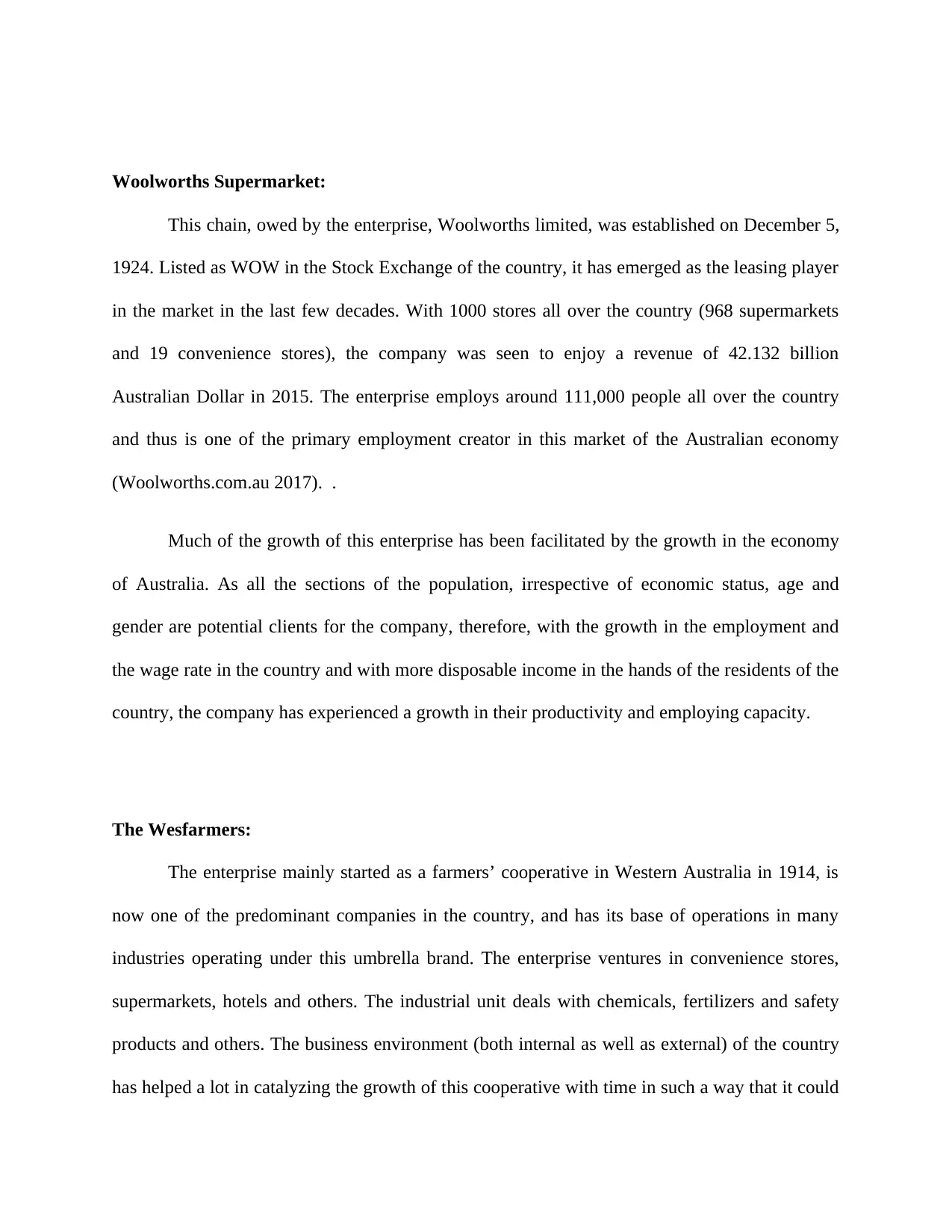
Woolworths Supermarket:
This chain, owed by the enterprise, Woolworths limited, was established on December 5,
1924. Listed as WOW in the Stock Exchange of the country, it has emerged as the leasing player
in the market in the last few decades. With 1000 stores all over the country (968 supermarkets
and 19 convenience stores), the company was seen to enjoy a revenue of 42.132 billion
Australian Dollar in 2015. The enterprise employs around 111,000 people all over the country
and thus is one of the primary employment creator in this market of the Australian economy
(Woolworths.com.au 2017). .
Much of the growth of this enterprise has been facilitated by the growth in the economy
of Australia. As all the sections of the population, irrespective of economic status, age and
gender are potential clients for the company, therefore, with the growth in the employment and
the wage rate in the country and with more disposable income in the hands of the residents of the
country, the company has experienced a growth in their productivity and employing capacity.
The Wesfarmers:
The enterprise mainly started as a farmers’ cooperative in Western Australia in 1914, is
now one of the predominant companies in the country, and has its base of operations in many
industries operating under this umbrella brand. The enterprise ventures in convenience stores,
supermarkets, hotels and others. The industrial unit deals with chemicals, fertilizers and safety
products and others. The business environment (both internal as well as external) of the country
has helped a lot in catalyzing the growth of this cooperative with time in such a way that it could
This chain, owed by the enterprise, Woolworths limited, was established on December 5,
1924. Listed as WOW in the Stock Exchange of the country, it has emerged as the leasing player
in the market in the last few decades. With 1000 stores all over the country (968 supermarkets
and 19 convenience stores), the company was seen to enjoy a revenue of 42.132 billion
Australian Dollar in 2015. The enterprise employs around 111,000 people all over the country
and thus is one of the primary employment creator in this market of the Australian economy
(Woolworths.com.au 2017). .
Much of the growth of this enterprise has been facilitated by the growth in the economy
of Australia. As all the sections of the population, irrespective of economic status, age and
gender are potential clients for the company, therefore, with the growth in the employment and
the wage rate in the country and with more disposable income in the hands of the residents of the
country, the company has experienced a growth in their productivity and employing capacity.
The Wesfarmers:
The enterprise mainly started as a farmers’ cooperative in Western Australia in 1914, is
now one of the predominant companies in the country, and has its base of operations in many
industries operating under this umbrella brand. The enterprise ventures in convenience stores,
supermarkets, hotels and others. The industrial unit deals with chemicals, fertilizers and safety
products and others. The business environment (both internal as well as external) of the country
has helped a lot in catalyzing the growth of this cooperative with time in such a way that it could
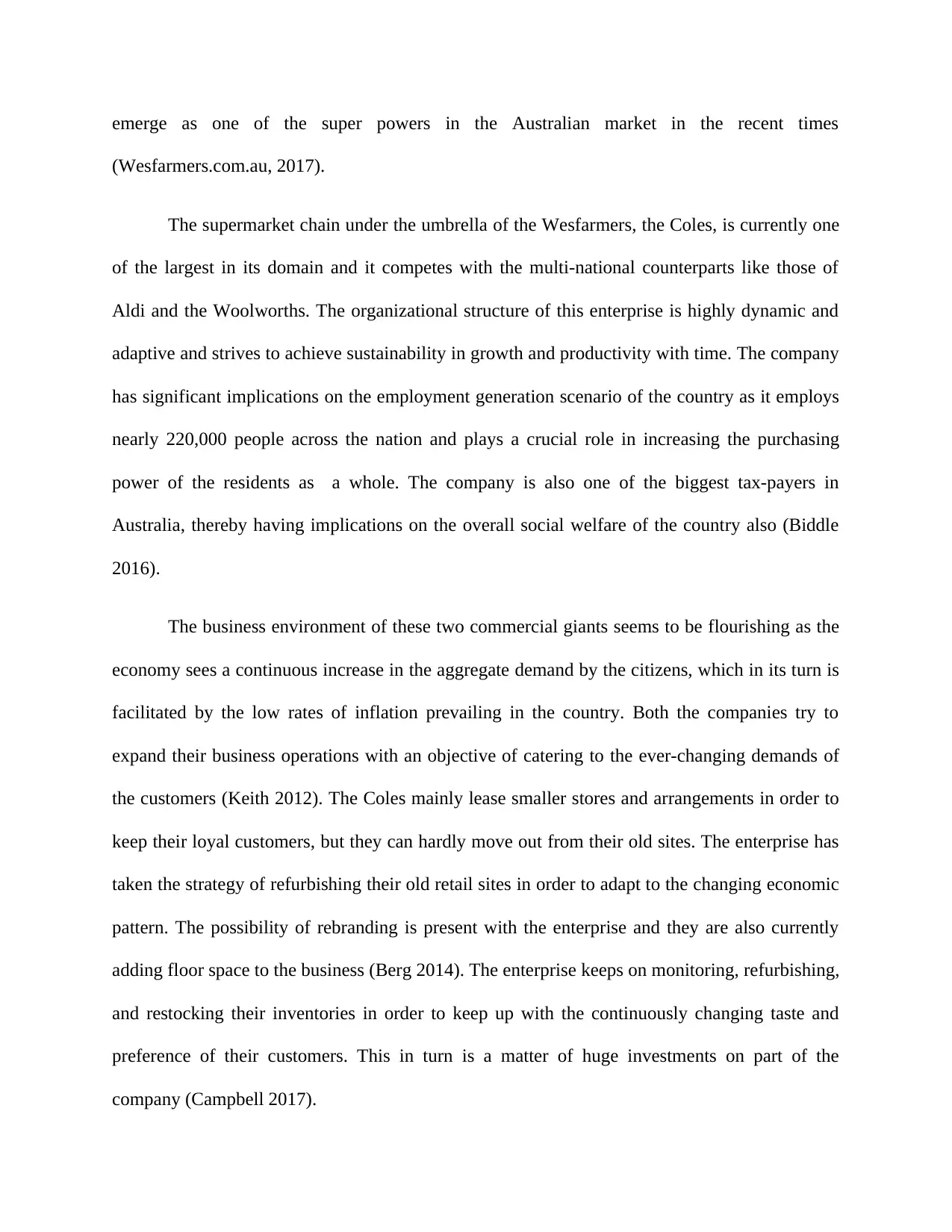
emerge as one of the super powers in the Australian market in the recent times
(Wesfarmers.com.au, 2017).
The supermarket chain under the umbrella of the Wesfarmers, the Coles, is currently one
of the largest in its domain and it competes with the multi-national counterparts like those of
Aldi and the Woolworths. The organizational structure of this enterprise is highly dynamic and
adaptive and strives to achieve sustainability in growth and productivity with time. The company
has significant implications on the employment generation scenario of the country as it employs
nearly 220,000 people across the nation and plays a crucial role in increasing the purchasing
power of the residents as a whole. The company is also one of the biggest tax-payers in
Australia, thereby having implications on the overall social welfare of the country also (Biddle
2016).
The business environment of these two commercial giants seems to be flourishing as the
economy sees a continuous increase in the aggregate demand by the citizens, which in its turn is
facilitated by the low rates of inflation prevailing in the country. Both the companies try to
expand their business operations with an objective of catering to the ever-changing demands of
the customers (Keith 2012). The Coles mainly lease smaller stores and arrangements in order to
keep their loyal customers, but they can hardly move out from their old sites. The enterprise has
taken the strategy of refurbishing their old retail sites in order to adapt to the changing economic
pattern. The possibility of rebranding is present with the enterprise and they are also currently
adding floor space to the business (Berg 2014). The enterprise keeps on monitoring, refurbishing,
and restocking their inventories in order to keep up with the continuously changing taste and
preference of their customers. This in turn is a matter of huge investments on part of the
company (Campbell 2017).
(Wesfarmers.com.au, 2017).
The supermarket chain under the umbrella of the Wesfarmers, the Coles, is currently one
of the largest in its domain and it competes with the multi-national counterparts like those of
Aldi and the Woolworths. The organizational structure of this enterprise is highly dynamic and
adaptive and strives to achieve sustainability in growth and productivity with time. The company
has significant implications on the employment generation scenario of the country as it employs
nearly 220,000 people across the nation and plays a crucial role in increasing the purchasing
power of the residents as a whole. The company is also one of the biggest tax-payers in
Australia, thereby having implications on the overall social welfare of the country also (Biddle
2016).
The business environment of these two commercial giants seems to be flourishing as the
economy sees a continuous increase in the aggregate demand by the citizens, which in its turn is
facilitated by the low rates of inflation prevailing in the country. Both the companies try to
expand their business operations with an objective of catering to the ever-changing demands of
the customers (Keith 2012). The Coles mainly lease smaller stores and arrangements in order to
keep their loyal customers, but they can hardly move out from their old sites. The enterprise has
taken the strategy of refurbishing their old retail sites in order to adapt to the changing economic
pattern. The possibility of rebranding is present with the enterprise and they are also currently
adding floor space to the business (Berg 2014). The enterprise keeps on monitoring, refurbishing,
and restocking their inventories in order to keep up with the continuously changing taste and
preference of their customers. This in turn is a matter of huge investments on part of the
company (Campbell 2017).
Secure Best Marks with AI Grader
Need help grading? Try our AI Grader for instant feedback on your assignments.
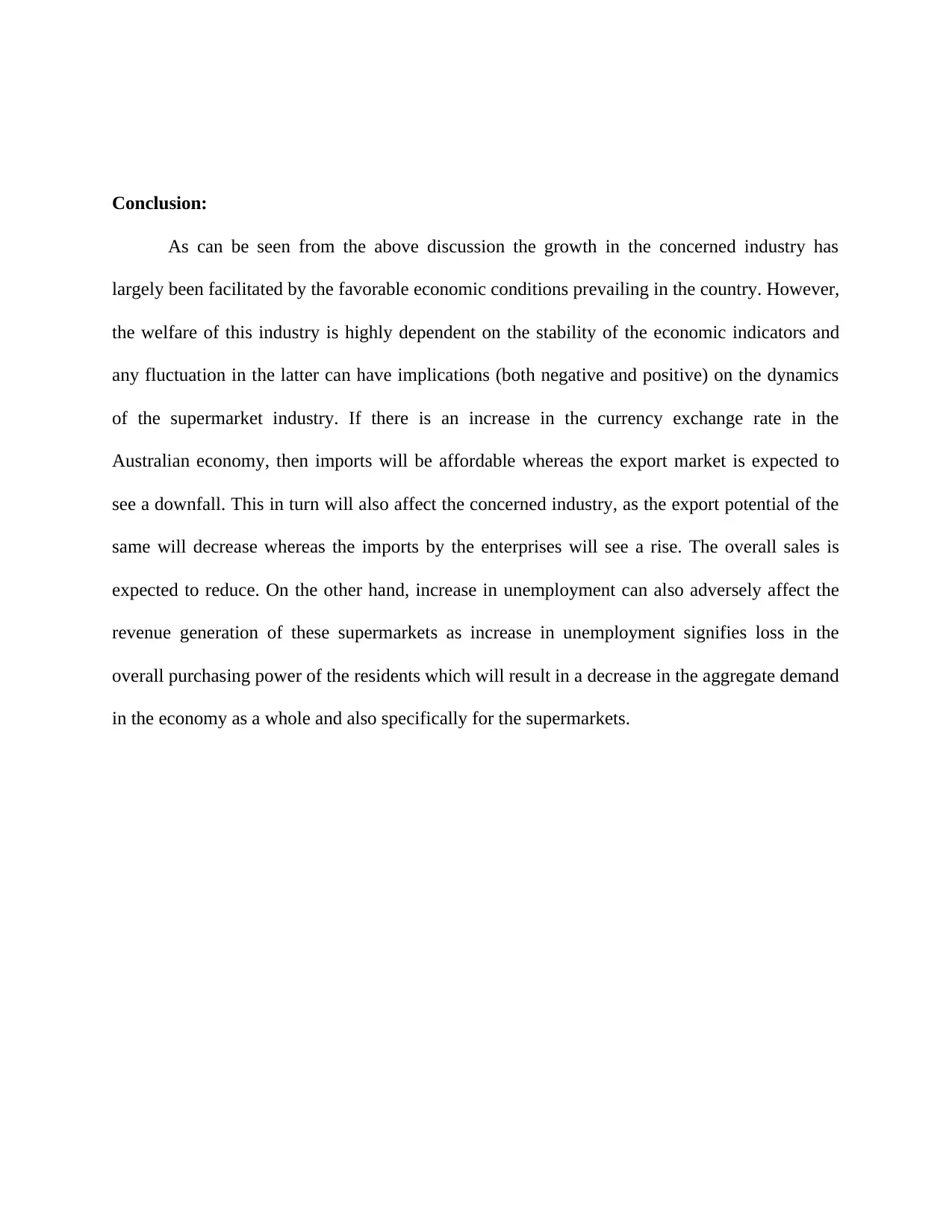
Conclusion:
As can be seen from the above discussion the growth in the concerned industry has
largely been facilitated by the favorable economic conditions prevailing in the country. However,
the welfare of this industry is highly dependent on the stability of the economic indicators and
any fluctuation in the latter can have implications (both negative and positive) on the dynamics
of the supermarket industry. If there is an increase in the currency exchange rate in the
Australian economy, then imports will be affordable whereas the export market is expected to
see a downfall. This in turn will also affect the concerned industry, as the export potential of the
same will decrease whereas the imports by the enterprises will see a rise. The overall sales is
expected to reduce. On the other hand, increase in unemployment can also adversely affect the
revenue generation of these supermarkets as increase in unemployment signifies loss in the
overall purchasing power of the residents which will result in a decrease in the aggregate demand
in the economy as a whole and also specifically for the supermarkets.
As can be seen from the above discussion the growth in the concerned industry has
largely been facilitated by the favorable economic conditions prevailing in the country. However,
the welfare of this industry is highly dependent on the stability of the economic indicators and
any fluctuation in the latter can have implications (both negative and positive) on the dynamics
of the supermarket industry. If there is an increase in the currency exchange rate in the
Australian economy, then imports will be affordable whereas the export market is expected to
see a downfall. This in turn will also affect the concerned industry, as the export potential of the
same will decrease whereas the imports by the enterprises will see a rise. The overall sales is
expected to reduce. On the other hand, increase in unemployment can also adversely affect the
revenue generation of these supermarkets as increase in unemployment signifies loss in the
overall purchasing power of the residents which will result in a decrease in the aggregate demand
in the economy as a whole and also specifically for the supermarkets.
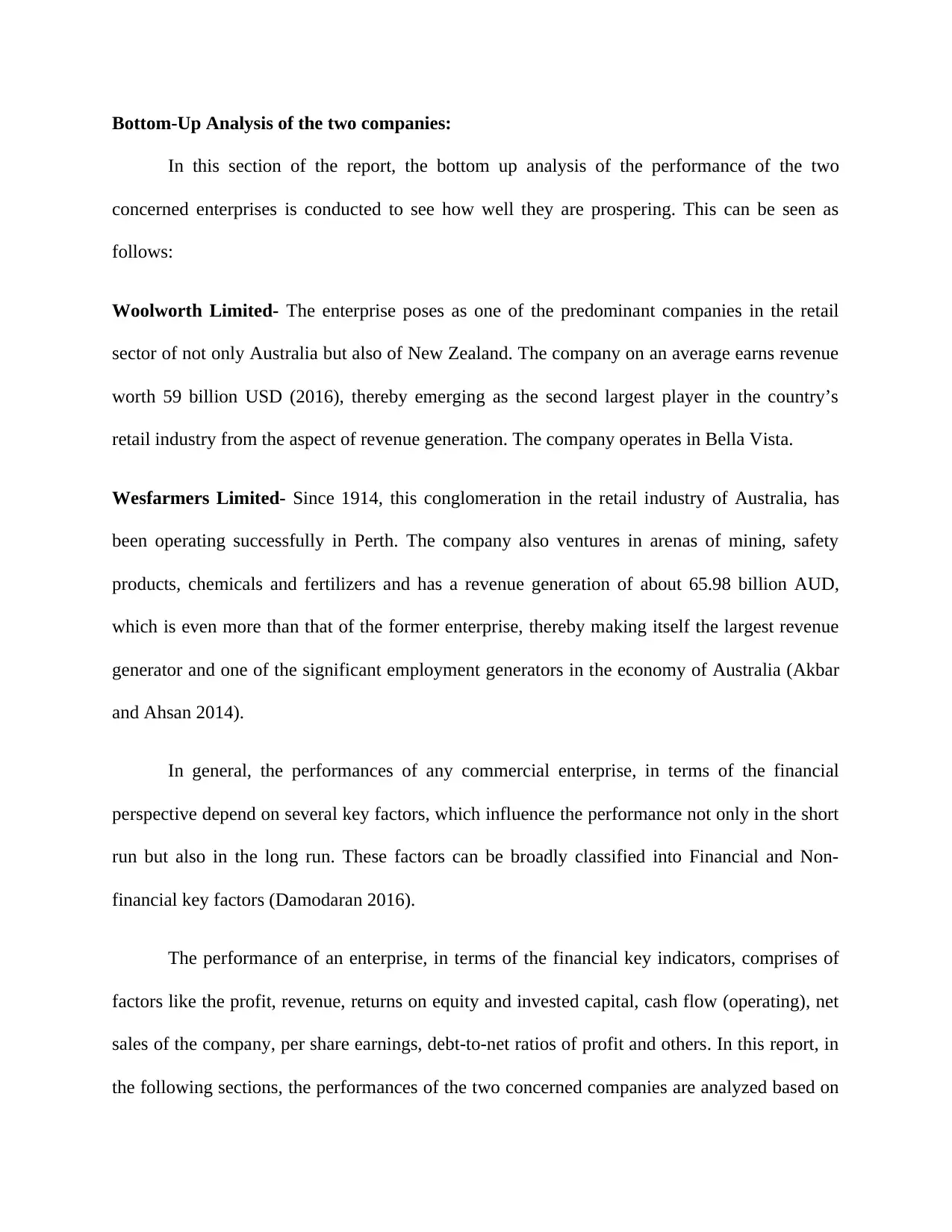
Bottom-Up Analysis of the two companies:
In this section of the report, the bottom up analysis of the performance of the two
concerned enterprises is conducted to see how well they are prospering. This can be seen as
follows:
Woolworth Limited- The enterprise poses as one of the predominant companies in the retail
sector of not only Australia but also of New Zealand. The company on an average earns revenue
worth 59 billion USD (2016), thereby emerging as the second largest player in the country’s
retail industry from the aspect of revenue generation. The company operates in Bella Vista.
Wesfarmers Limited- Since 1914, this conglomeration in the retail industry of Australia, has
been operating successfully in Perth. The company also ventures in arenas of mining, safety
products, chemicals and fertilizers and has a revenue generation of about 65.98 billion AUD,
which is even more than that of the former enterprise, thereby making itself the largest revenue
generator and one of the significant employment generators in the economy of Australia (Akbar
and Ahsan 2014).
In general, the performances of any commercial enterprise, in terms of the financial
perspective depend on several key factors, which influence the performance not only in the short
run but also in the long run. These factors can be broadly classified into Financial and Non-
financial key factors (Damodaran 2016).
The performance of an enterprise, in terms of the financial key indicators, comprises of
factors like the profit, revenue, returns on equity and invested capital, cash flow (operating), net
sales of the company, per share earnings, debt-to-net ratios of profit and others. In this report, in
the following sections, the performances of the two concerned companies are analyzed based on
In this section of the report, the bottom up analysis of the performance of the two
concerned enterprises is conducted to see how well they are prospering. This can be seen as
follows:
Woolworth Limited- The enterprise poses as one of the predominant companies in the retail
sector of not only Australia but also of New Zealand. The company on an average earns revenue
worth 59 billion USD (2016), thereby emerging as the second largest player in the country’s
retail industry from the aspect of revenue generation. The company operates in Bella Vista.
Wesfarmers Limited- Since 1914, this conglomeration in the retail industry of Australia, has
been operating successfully in Perth. The company also ventures in arenas of mining, safety
products, chemicals and fertilizers and has a revenue generation of about 65.98 billion AUD,
which is even more than that of the former enterprise, thereby making itself the largest revenue
generator and one of the significant employment generators in the economy of Australia (Akbar
and Ahsan 2014).
In general, the performances of any commercial enterprise, in terms of the financial
perspective depend on several key factors, which influence the performance not only in the short
run but also in the long run. These factors can be broadly classified into Financial and Non-
financial key factors (Damodaran 2016).
The performance of an enterprise, in terms of the financial key indicators, comprises of
factors like the profit, revenue, returns on equity and invested capital, cash flow (operating), net
sales of the company, per share earnings, debt-to-net ratios of profit and others. In this report, in
the following sections, the performances of the two concerned companies are analyzed based on
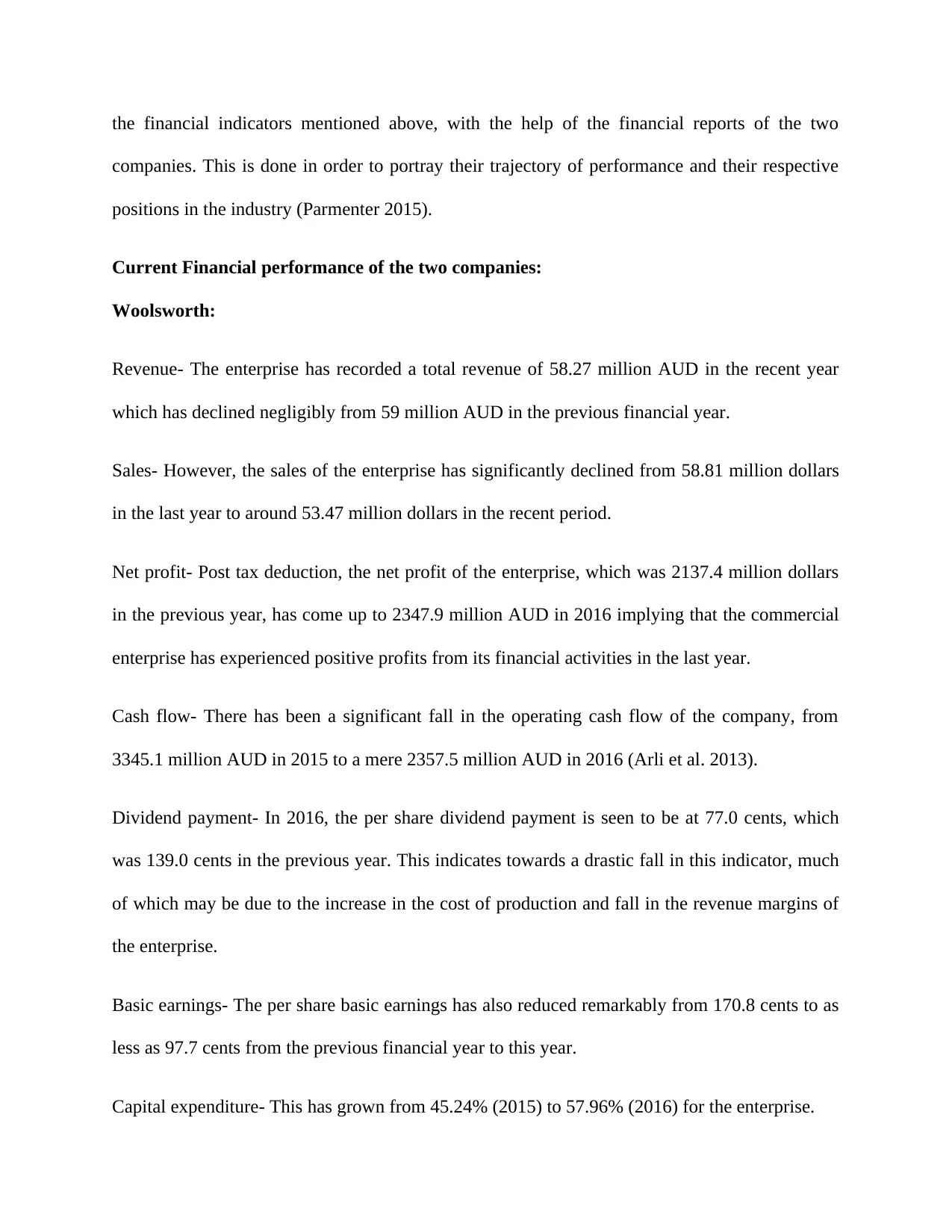
the financial indicators mentioned above, with the help of the financial reports of the two
companies. This is done in order to portray their trajectory of performance and their respective
positions in the industry (Parmenter 2015).
Current Financial performance of the two companies:
Woolsworth:
Revenue- The enterprise has recorded a total revenue of 58.27 million AUD in the recent year
which has declined negligibly from 59 million AUD in the previous financial year.
Sales- However, the sales of the enterprise has significantly declined from 58.81 million dollars
in the last year to around 53.47 million dollars in the recent period.
Net profit- Post tax deduction, the net profit of the enterprise, which was 2137.4 million dollars
in the previous year, has come up to 2347.9 million AUD in 2016 implying that the commercial
enterprise has experienced positive profits from its financial activities in the last year.
Cash flow- There has been a significant fall in the operating cash flow of the company, from
3345.1 million AUD in 2015 to a mere 2357.5 million AUD in 2016 (Arli et al. 2013).
Dividend payment- In 2016, the per share dividend payment is seen to be at 77.0 cents, which
was 139.0 cents in the previous year. This indicates towards a drastic fall in this indicator, much
of which may be due to the increase in the cost of production and fall in the revenue margins of
the enterprise.
Basic earnings- The per share basic earnings has also reduced remarkably from 170.8 cents to as
less as 97.7 cents from the previous financial year to this year.
Capital expenditure- This has grown from 45.24% (2015) to 57.96% (2016) for the enterprise.
companies. This is done in order to portray their trajectory of performance and their respective
positions in the industry (Parmenter 2015).
Current Financial performance of the two companies:
Woolsworth:
Revenue- The enterprise has recorded a total revenue of 58.27 million AUD in the recent year
which has declined negligibly from 59 million AUD in the previous financial year.
Sales- However, the sales of the enterprise has significantly declined from 58.81 million dollars
in the last year to around 53.47 million dollars in the recent period.
Net profit- Post tax deduction, the net profit of the enterprise, which was 2137.4 million dollars
in the previous year, has come up to 2347.9 million AUD in 2016 implying that the commercial
enterprise has experienced positive profits from its financial activities in the last year.
Cash flow- There has been a significant fall in the operating cash flow of the company, from
3345.1 million AUD in 2015 to a mere 2357.5 million AUD in 2016 (Arli et al. 2013).
Dividend payment- In 2016, the per share dividend payment is seen to be at 77.0 cents, which
was 139.0 cents in the previous year. This indicates towards a drastic fall in this indicator, much
of which may be due to the increase in the cost of production and fall in the revenue margins of
the enterprise.
Basic earnings- The per share basic earnings has also reduced remarkably from 170.8 cents to as
less as 97.7 cents from the previous financial year to this year.
Capital expenditure- This has grown from 45.24% (2015) to 57.96% (2016) for the enterprise.
Paraphrase This Document
Need a fresh take? Get an instant paraphrase of this document with our AI Paraphraser
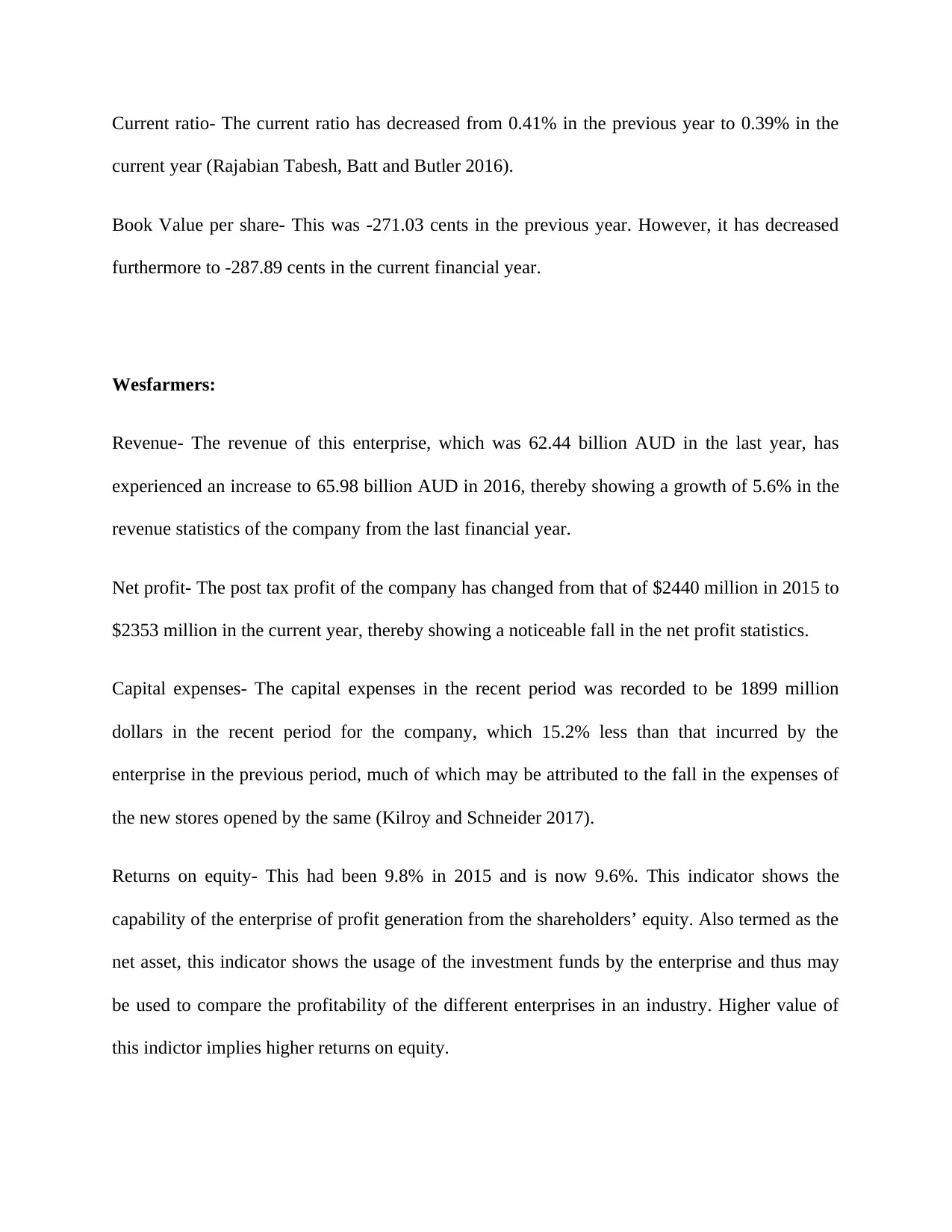
Current ratio- The current ratio has decreased from 0.41% in the previous year to 0.39% in the
current year (Rajabian Tabesh, Batt and Butler 2016).
Book Value per share- This was -271.03 cents in the previous year. However, it has decreased
furthermore to -287.89 cents in the current financial year.
Wesfarmers:
Revenue- The revenue of this enterprise, which was 62.44 billion AUD in the last year, has
experienced an increase to 65.98 billion AUD in 2016, thereby showing a growth of 5.6% in the
revenue statistics of the company from the last financial year.
Net profit- The post tax profit of the company has changed from that of $2440 million in 2015 to
$2353 million in the current year, thereby showing a noticeable fall in the net profit statistics.
Capital expenses- The capital expenses in the recent period was recorded to be 1899 million
dollars in the recent period for the company, which 15.2% less than that incurred by the
enterprise in the previous period, much of which may be attributed to the fall in the expenses of
the new stores opened by the same (Kilroy and Schneider 2017).
Returns on equity- This had been 9.8% in 2015 and is now 9.6%. This indicator shows the
capability of the enterprise of profit generation from the shareholders’ equity. Also termed as the
net asset, this indicator shows the usage of the investment funds by the enterprise and thus may
be used to compare the profitability of the different enterprises in an industry. Higher value of
this indictor implies higher returns on equity.
current year (Rajabian Tabesh, Batt and Butler 2016).
Book Value per share- This was -271.03 cents in the previous year. However, it has decreased
furthermore to -287.89 cents in the current financial year.
Wesfarmers:
Revenue- The revenue of this enterprise, which was 62.44 billion AUD in the last year, has
experienced an increase to 65.98 billion AUD in 2016, thereby showing a growth of 5.6% in the
revenue statistics of the company from the last financial year.
Net profit- The post tax profit of the company has changed from that of $2440 million in 2015 to
$2353 million in the current year, thereby showing a noticeable fall in the net profit statistics.
Capital expenses- The capital expenses in the recent period was recorded to be 1899 million
dollars in the recent period for the company, which 15.2% less than that incurred by the
enterprise in the previous period, much of which may be attributed to the fall in the expenses of
the new stores opened by the same (Kilroy and Schneider 2017).
Returns on equity- This had been 9.8% in 2015 and is now 9.6%. This indicator shows the
capability of the enterprise of profit generation from the shareholders’ equity. Also termed as the
net asset, this indicator shows the usage of the investment funds by the enterprise and thus may
be used to compare the profitability of the different enterprises in an industry. Higher value of
this indictor implies higher returns on equity.
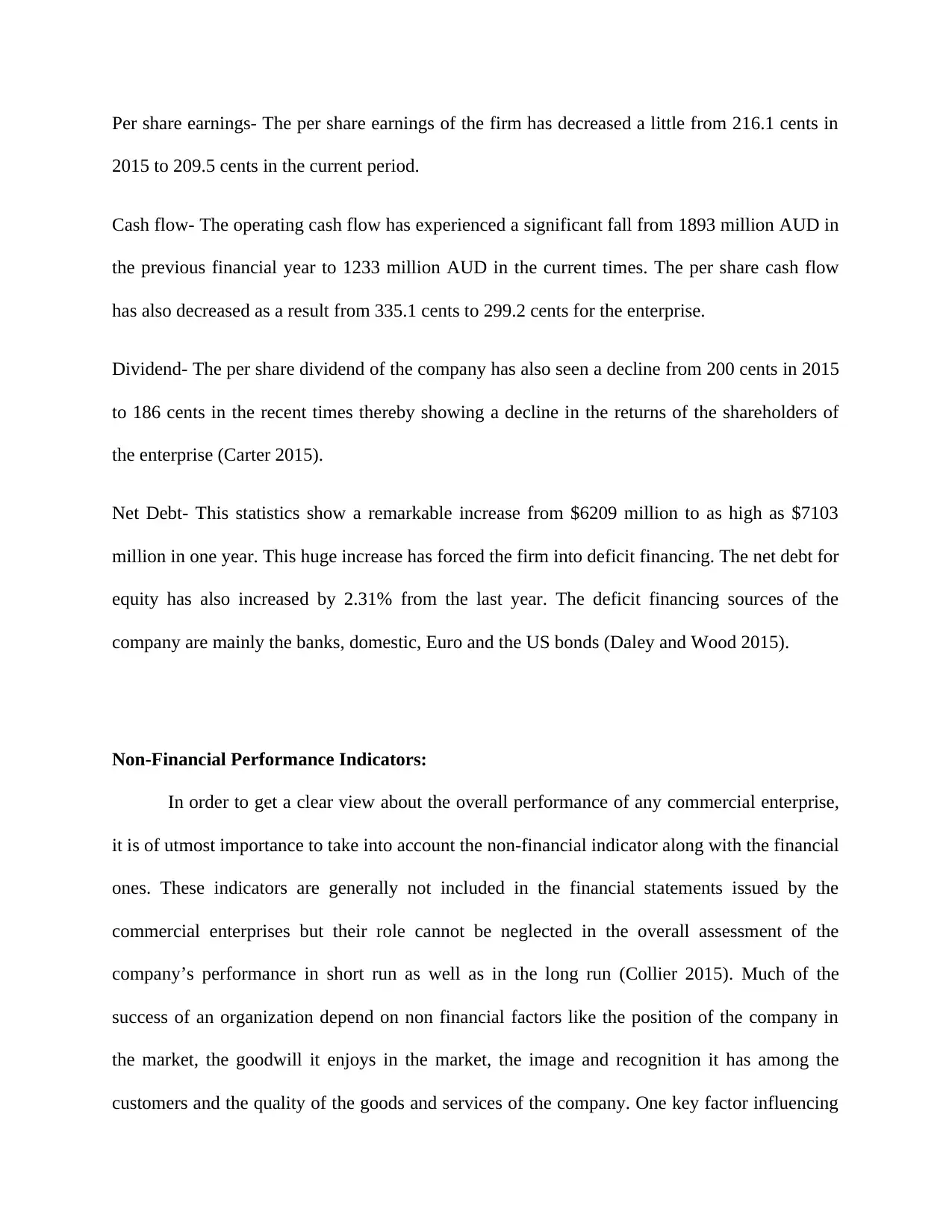
Per share earnings- The per share earnings of the firm has decreased a little from 216.1 cents in
2015 to 209.5 cents in the current period.
Cash flow- The operating cash flow has experienced a significant fall from 1893 million AUD in
the previous financial year to 1233 million AUD in the current times. The per share cash flow
has also decreased as a result from 335.1 cents to 299.2 cents for the enterprise.
Dividend- The per share dividend of the company has also seen a decline from 200 cents in 2015
to 186 cents in the recent times thereby showing a decline in the returns of the shareholders of
the enterprise (Carter 2015).
Net Debt- This statistics show a remarkable increase from $6209 million to as high as $7103
million in one year. This huge increase has forced the firm into deficit financing. The net debt for
equity has also increased by 2.31% from the last year. The deficit financing sources of the
company are mainly the banks, domestic, Euro and the US bonds (Daley and Wood 2015).
Non-Financial Performance Indicators:
In order to get a clear view about the overall performance of any commercial enterprise,
it is of utmost importance to take into account the non-financial indicator along with the financial
ones. These indicators are generally not included in the financial statements issued by the
commercial enterprises but their role cannot be neglected in the overall assessment of the
company’s performance in short run as well as in the long run (Collier 2015). Much of the
success of an organization depend on non financial factors like the position of the company in
the market, the goodwill it enjoys in the market, the image and recognition it has among the
customers and the quality of the goods and services of the company. One key factor influencing
2015 to 209.5 cents in the current period.
Cash flow- The operating cash flow has experienced a significant fall from 1893 million AUD in
the previous financial year to 1233 million AUD in the current times. The per share cash flow
has also decreased as a result from 335.1 cents to 299.2 cents for the enterprise.
Dividend- The per share dividend of the company has also seen a decline from 200 cents in 2015
to 186 cents in the recent times thereby showing a decline in the returns of the shareholders of
the enterprise (Carter 2015).
Net Debt- This statistics show a remarkable increase from $6209 million to as high as $7103
million in one year. This huge increase has forced the firm into deficit financing. The net debt for
equity has also increased by 2.31% from the last year. The deficit financing sources of the
company are mainly the banks, domestic, Euro and the US bonds (Daley and Wood 2015).
Non-Financial Performance Indicators:
In order to get a clear view about the overall performance of any commercial enterprise,
it is of utmost importance to take into account the non-financial indicator along with the financial
ones. These indicators are generally not included in the financial statements issued by the
commercial enterprises but their role cannot be neglected in the overall assessment of the
company’s performance in short run as well as in the long run (Collier 2015). Much of the
success of an organization depend on non financial factors like the position of the company in
the market, the goodwill it enjoys in the market, the image and recognition it has among the
customers and the quality of the goods and services of the company. One key factor influencing
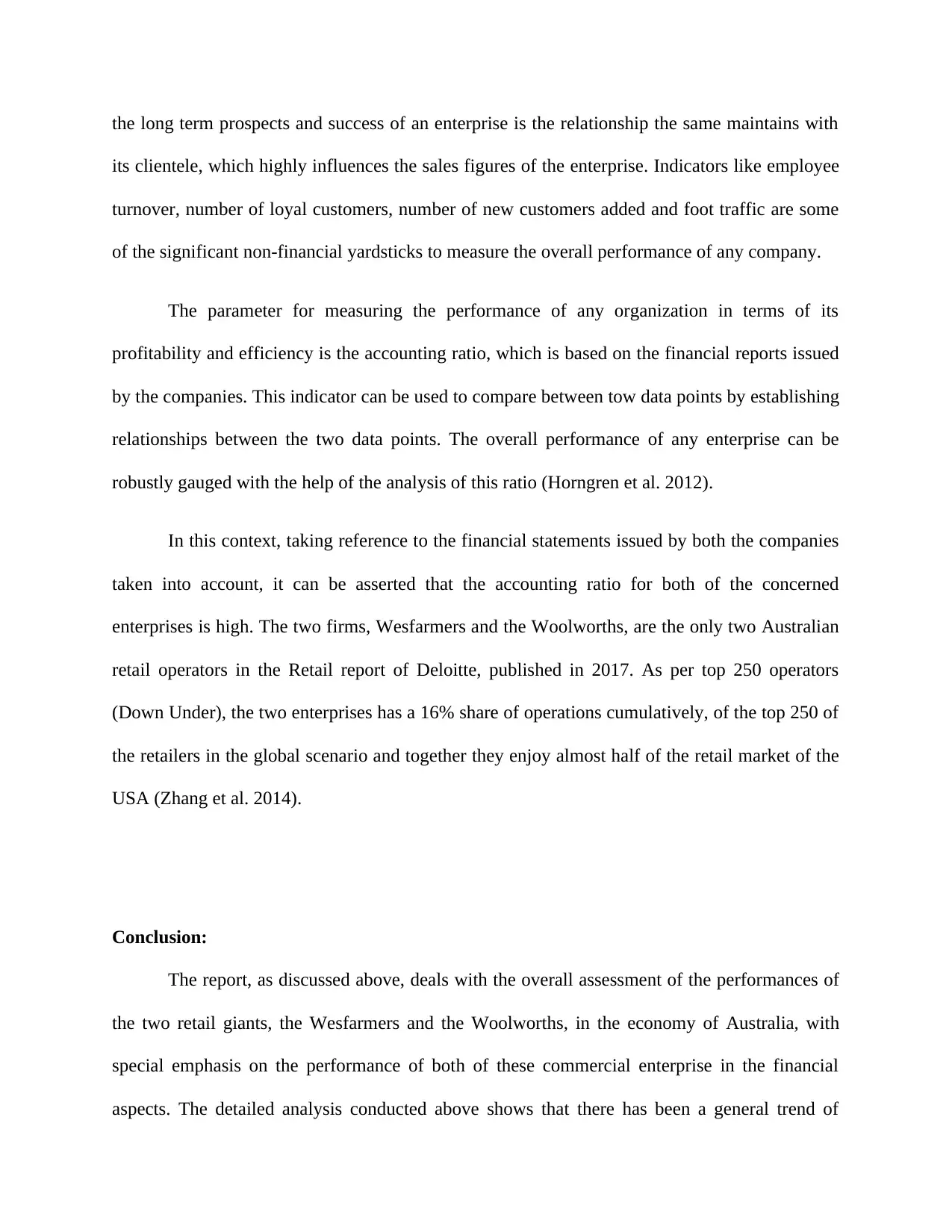
the long term prospects and success of an enterprise is the relationship the same maintains with
its clientele, which highly influences the sales figures of the enterprise. Indicators like employee
turnover, number of loyal customers, number of new customers added and foot traffic are some
of the significant non-financial yardsticks to measure the overall performance of any company.
The parameter for measuring the performance of any organization in terms of its
profitability and efficiency is the accounting ratio, which is based on the financial reports issued
by the companies. This indicator can be used to compare between tow data points by establishing
relationships between the two data points. The overall performance of any enterprise can be
robustly gauged with the help of the analysis of this ratio (Horngren et al. 2012).
In this context, taking reference to the financial statements issued by both the companies
taken into account, it can be asserted that the accounting ratio for both of the concerned
enterprises is high. The two firms, Wesfarmers and the Woolworths, are the only two Australian
retail operators in the Retail report of Deloitte, published in 2017. As per top 250 operators
(Down Under), the two enterprises has a 16% share of operations cumulatively, of the top 250 of
the retailers in the global scenario and together they enjoy almost half of the retail market of the
USA (Zhang et al. 2014).
Conclusion:
The report, as discussed above, deals with the overall assessment of the performances of
the two retail giants, the Wesfarmers and the Woolworths, in the economy of Australia, with
special emphasis on the performance of both of these commercial enterprise in the financial
aspects. The detailed analysis conducted above shows that there has been a general trend of
its clientele, which highly influences the sales figures of the enterprise. Indicators like employee
turnover, number of loyal customers, number of new customers added and foot traffic are some
of the significant non-financial yardsticks to measure the overall performance of any company.
The parameter for measuring the performance of any organization in terms of its
profitability and efficiency is the accounting ratio, which is based on the financial reports issued
by the companies. This indicator can be used to compare between tow data points by establishing
relationships between the two data points. The overall performance of any enterprise can be
robustly gauged with the help of the analysis of this ratio (Horngren et al. 2012).
In this context, taking reference to the financial statements issued by both the companies
taken into account, it can be asserted that the accounting ratio for both of the concerned
enterprises is high. The two firms, Wesfarmers and the Woolworths, are the only two Australian
retail operators in the Retail report of Deloitte, published in 2017. As per top 250 operators
(Down Under), the two enterprises has a 16% share of operations cumulatively, of the top 250 of
the retailers in the global scenario and together they enjoy almost half of the retail market of the
USA (Zhang et al. 2014).
Conclusion:
The report, as discussed above, deals with the overall assessment of the performances of
the two retail giants, the Wesfarmers and the Woolworths, in the economy of Australia, with
special emphasis on the performance of both of these commercial enterprise in the financial
aspects. The detailed analysis conducted above shows that there has been a general trend of
Secure Best Marks with AI Grader
Need help grading? Try our AI Grader for instant feedback on your assignments.
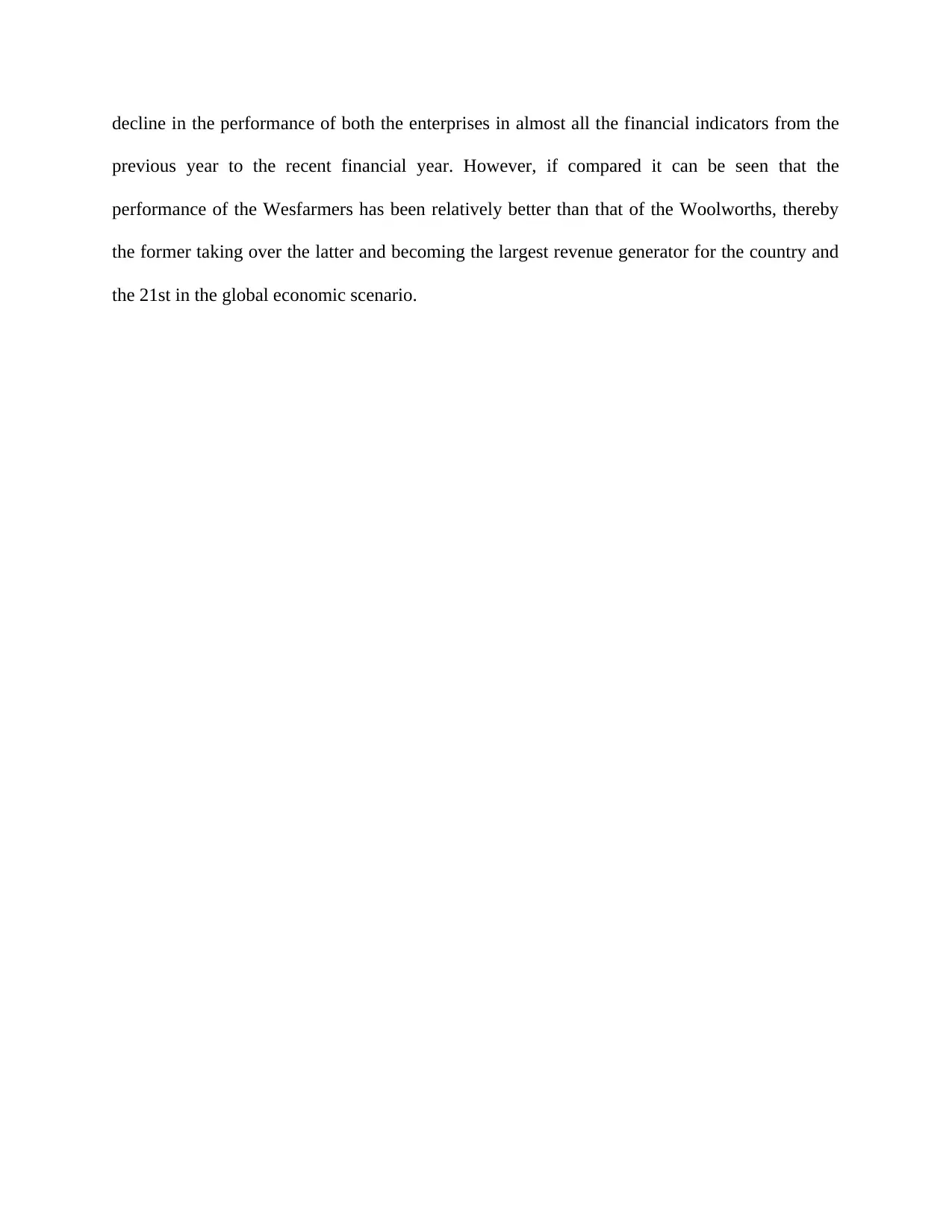
decline in the performance of both the enterprises in almost all the financial indicators from the
previous year to the recent financial year. However, if compared it can be seen that the
performance of the Wesfarmers has been relatively better than that of the Woolworths, thereby
the former taking over the latter and becoming the largest revenue generator for the country and
the 21st in the global economic scenario.
previous year to the recent financial year. However, if compared it can be seen that the
performance of the Wesfarmers has been relatively better than that of the Woolworths, thereby
the former taking over the latter and becoming the largest revenue generator for the country and
the 21st in the global economic scenario.
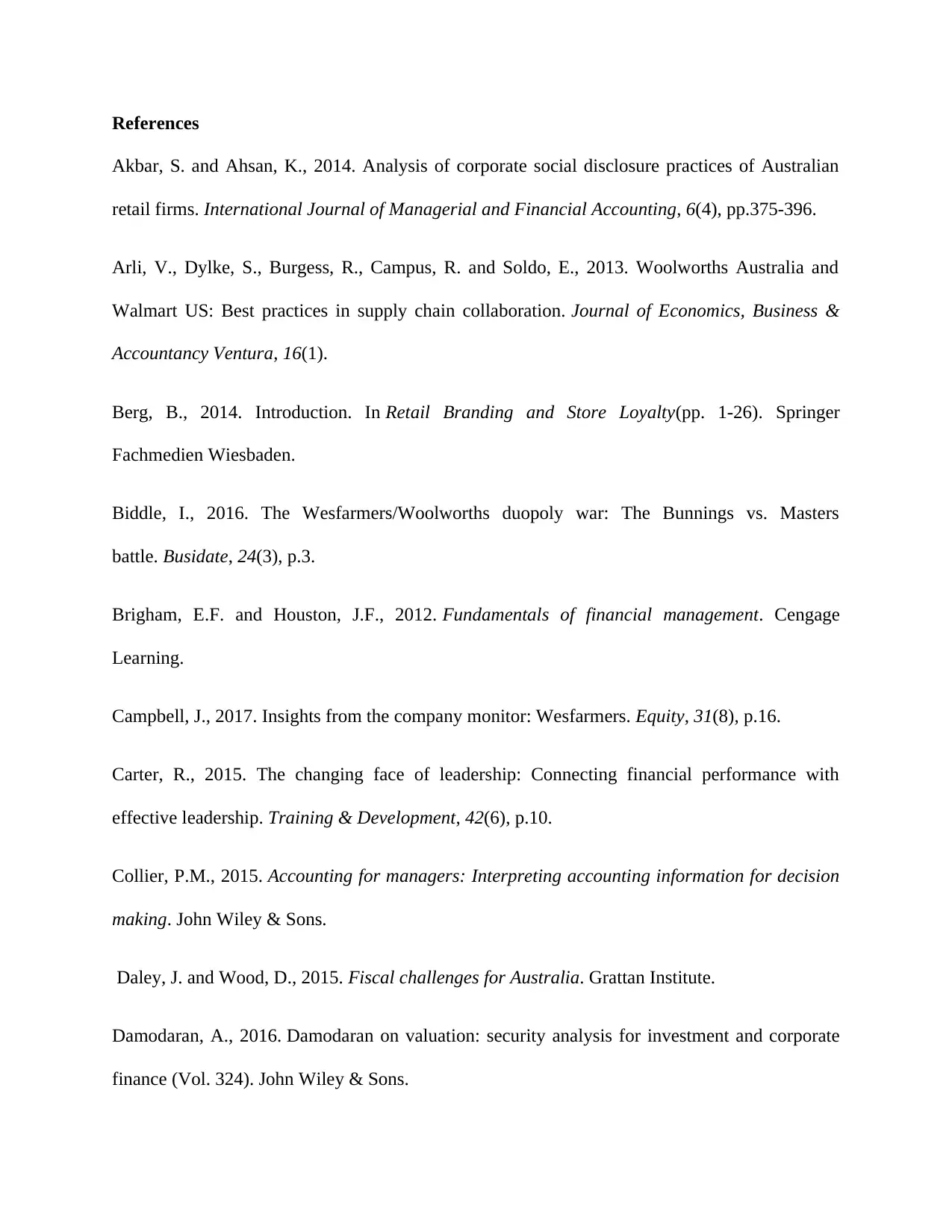
References
Akbar, S. and Ahsan, K., 2014. Analysis of corporate social disclosure practices of Australian
retail firms. International Journal of Managerial and Financial Accounting, 6(4), pp.375-396.
Arli, V., Dylke, S., Burgess, R., Campus, R. and Soldo, E., 2013. Woolworths Australia and
Walmart US: Best practices in supply chain collaboration. Journal of Economics, Business &
Accountancy Ventura, 16(1).
Berg, B., 2014. Introduction. In Retail Branding and Store Loyalty(pp. 1-26). Springer
Fachmedien Wiesbaden.
Biddle, I., 2016. The Wesfarmers/Woolworths duopoly war: The Bunnings vs. Masters
battle. Busidate, 24(3), p.3.
Brigham, E.F. and Houston, J.F., 2012. Fundamentals of financial management. Cengage
Learning.
Campbell, J., 2017. Insights from the company monitor: Wesfarmers. Equity, 31(8), p.16.
Carter, R., 2015. The changing face of leadership: Connecting financial performance with
effective leadership. Training & Development, 42(6), p.10.
Collier, P.M., 2015. Accounting for managers: Interpreting accounting information for decision
making. John Wiley & Sons.
Daley, J. and Wood, D., 2015. Fiscal challenges for Australia. Grattan Institute.
Damodaran, A., 2016. Damodaran on valuation: security analysis for investment and corporate
finance (Vol. 324). John Wiley & Sons.
Akbar, S. and Ahsan, K., 2014. Analysis of corporate social disclosure practices of Australian
retail firms. International Journal of Managerial and Financial Accounting, 6(4), pp.375-396.
Arli, V., Dylke, S., Burgess, R., Campus, R. and Soldo, E., 2013. Woolworths Australia and
Walmart US: Best practices in supply chain collaboration. Journal of Economics, Business &
Accountancy Ventura, 16(1).
Berg, B., 2014. Introduction. In Retail Branding and Store Loyalty(pp. 1-26). Springer
Fachmedien Wiesbaden.
Biddle, I., 2016. The Wesfarmers/Woolworths duopoly war: The Bunnings vs. Masters
battle. Busidate, 24(3), p.3.
Brigham, E.F. and Houston, J.F., 2012. Fundamentals of financial management. Cengage
Learning.
Campbell, J., 2017. Insights from the company monitor: Wesfarmers. Equity, 31(8), p.16.
Carter, R., 2015. The changing face of leadership: Connecting financial performance with
effective leadership. Training & Development, 42(6), p.10.
Collier, P.M., 2015. Accounting for managers: Interpreting accounting information for decision
making. John Wiley & Sons.
Daley, J. and Wood, D., 2015. Fiscal challenges for Australia. Grattan Institute.
Damodaran, A., 2016. Damodaran on valuation: security analysis for investment and corporate
finance (Vol. 324). John Wiley & Sons.
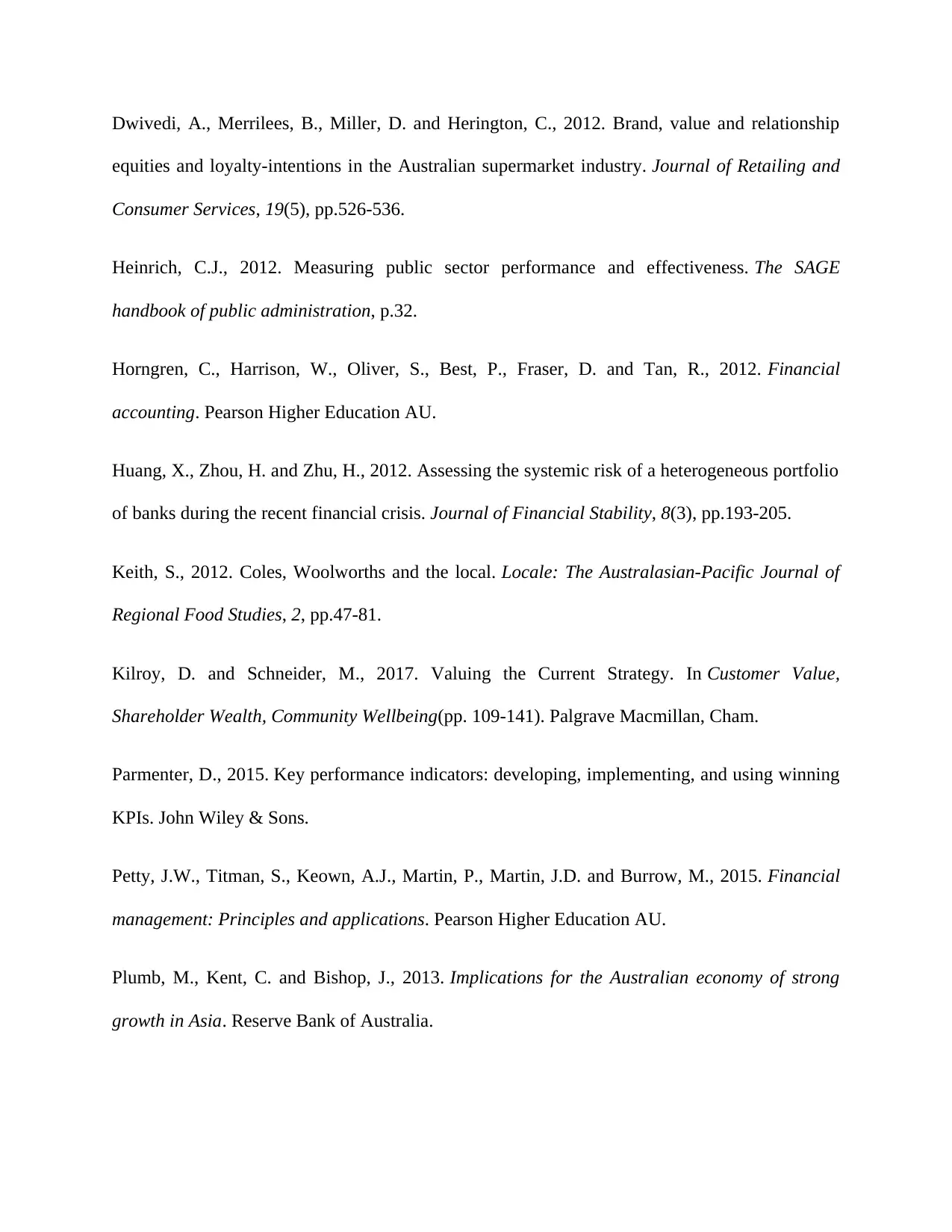
Dwivedi, A., Merrilees, B., Miller, D. and Herington, C., 2012. Brand, value and relationship
equities and loyalty-intentions in the Australian supermarket industry. Journal of Retailing and
Consumer Services, 19(5), pp.526-536.
Heinrich, C.J., 2012. Measuring public sector performance and effectiveness. The SAGE
handbook of public administration, p.32.
Horngren, C., Harrison, W., Oliver, S., Best, P., Fraser, D. and Tan, R., 2012. Financial
accounting. Pearson Higher Education AU.
Huang, X., Zhou, H. and Zhu, H., 2012. Assessing the systemic risk of a heterogeneous portfolio
of banks during the recent financial crisis. Journal of Financial Stability, 8(3), pp.193-205.
Keith, S., 2012. Coles, Woolworths and the local. Locale: The Australasian-Pacific Journal of
Regional Food Studies, 2, pp.47-81.
Kilroy, D. and Schneider, M., 2017. Valuing the Current Strategy. In Customer Value,
Shareholder Wealth, Community Wellbeing(pp. 109-141). Palgrave Macmillan, Cham.
Parmenter, D., 2015. Key performance indicators: developing, implementing, and using winning
KPIs. John Wiley & Sons.
Petty, J.W., Titman, S., Keown, A.J., Martin, P., Martin, J.D. and Burrow, M., 2015. Financial
management: Principles and applications. Pearson Higher Education AU.
Plumb, M., Kent, C. and Bishop, J., 2013. Implications for the Australian economy of strong
growth in Asia. Reserve Bank of Australia.
equities and loyalty-intentions in the Australian supermarket industry. Journal of Retailing and
Consumer Services, 19(5), pp.526-536.
Heinrich, C.J., 2012. Measuring public sector performance and effectiveness. The SAGE
handbook of public administration, p.32.
Horngren, C., Harrison, W., Oliver, S., Best, P., Fraser, D. and Tan, R., 2012. Financial
accounting. Pearson Higher Education AU.
Huang, X., Zhou, H. and Zhu, H., 2012. Assessing the systemic risk of a heterogeneous portfolio
of banks during the recent financial crisis. Journal of Financial Stability, 8(3), pp.193-205.
Keith, S., 2012. Coles, Woolworths and the local. Locale: The Australasian-Pacific Journal of
Regional Food Studies, 2, pp.47-81.
Kilroy, D. and Schneider, M., 2017. Valuing the Current Strategy. In Customer Value,
Shareholder Wealth, Community Wellbeing(pp. 109-141). Palgrave Macmillan, Cham.
Parmenter, D., 2015. Key performance indicators: developing, implementing, and using winning
KPIs. John Wiley & Sons.
Petty, J.W., Titman, S., Keown, A.J., Martin, P., Martin, J.D. and Burrow, M., 2015. Financial
management: Principles and applications. Pearson Higher Education AU.
Plumb, M., Kent, C. and Bishop, J., 2013. Implications for the Australian economy of strong
growth in Asia. Reserve Bank of Australia.
Paraphrase This Document
Need a fresh take? Get an instant paraphrase of this document with our AI Paraphraser
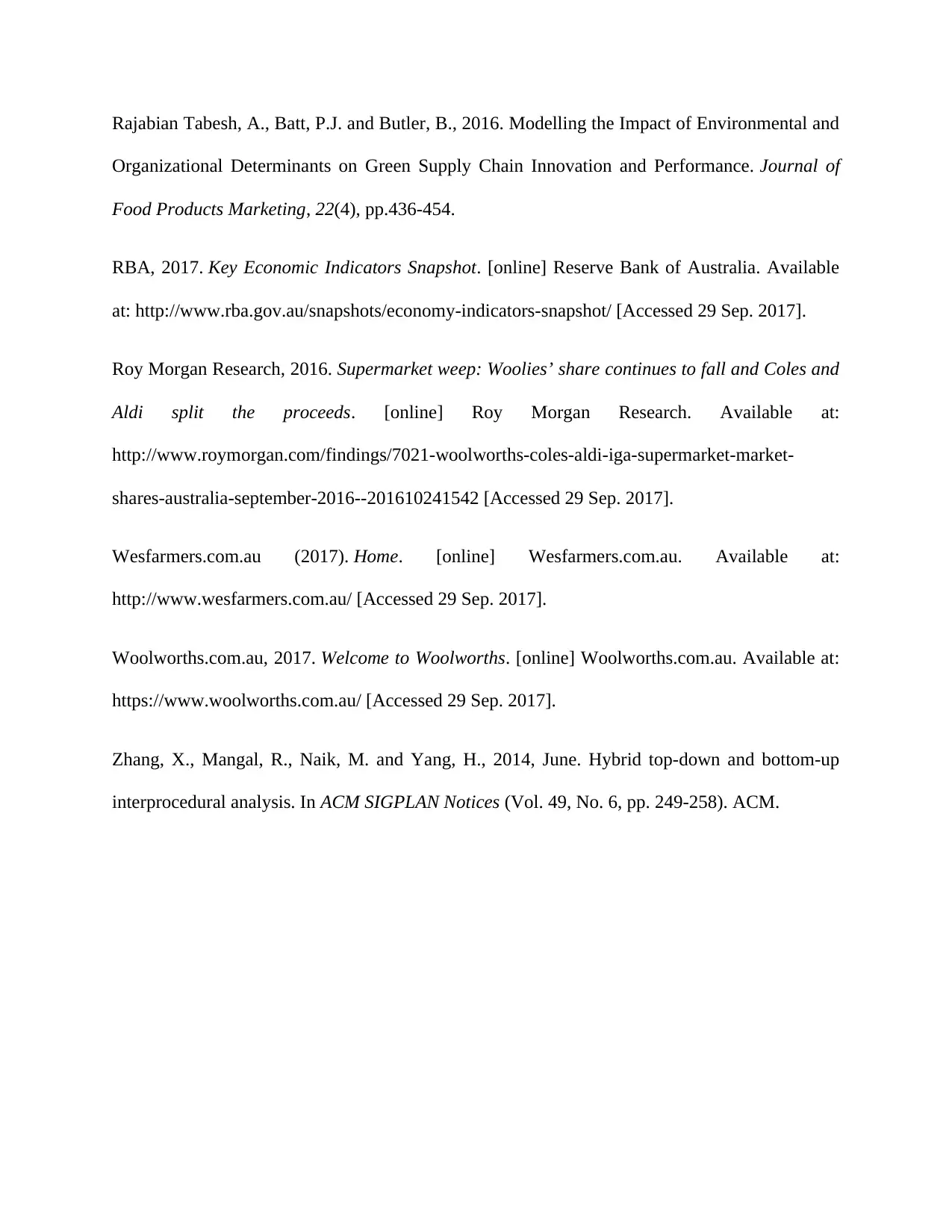
Rajabian Tabesh, A., Batt, P.J. and Butler, B., 2016. Modelling the Impact of Environmental and
Organizational Determinants on Green Supply Chain Innovation and Performance. Journal of
Food Products Marketing, 22(4), pp.436-454.
RBA, 2017. Key Economic Indicators Snapshot. [online] Reserve Bank of Australia. Available
at: http://www.rba.gov.au/snapshots/economy-indicators-snapshot/ [Accessed 29 Sep. 2017].
Roy Morgan Research, 2016. Supermarket weep: Woolies’ share continues to fall and Coles and
Aldi split the proceeds. [online] Roy Morgan Research. Available at:
http://www.roymorgan.com/findings/7021-woolworths-coles-aldi-iga-supermarket-market-
shares-australia-september-2016--201610241542 [Accessed 29 Sep. 2017].
Wesfarmers.com.au (2017). Home. [online] Wesfarmers.com.au. Available at:
http://www.wesfarmers.com.au/ [Accessed 29 Sep. 2017].
Woolworths.com.au, 2017. Welcome to Woolworths. [online] Woolworths.com.au. Available at:
https://www.woolworths.com.au/ [Accessed 29 Sep. 2017].
Zhang, X., Mangal, R., Naik, M. and Yang, H., 2014, June. Hybrid top-down and bottom-up
interprocedural analysis. In ACM SIGPLAN Notices (Vol. 49, No. 6, pp. 249-258). ACM.
Organizational Determinants on Green Supply Chain Innovation and Performance. Journal of
Food Products Marketing, 22(4), pp.436-454.
RBA, 2017. Key Economic Indicators Snapshot. [online] Reserve Bank of Australia. Available
at: http://www.rba.gov.au/snapshots/economy-indicators-snapshot/ [Accessed 29 Sep. 2017].
Roy Morgan Research, 2016. Supermarket weep: Woolies’ share continues to fall and Coles and
Aldi split the proceeds. [online] Roy Morgan Research. Available at:
http://www.roymorgan.com/findings/7021-woolworths-coles-aldi-iga-supermarket-market-
shares-australia-september-2016--201610241542 [Accessed 29 Sep. 2017].
Wesfarmers.com.au (2017). Home. [online] Wesfarmers.com.au. Available at:
http://www.wesfarmers.com.au/ [Accessed 29 Sep. 2017].
Woolworths.com.au, 2017. Welcome to Woolworths. [online] Woolworths.com.au. Available at:
https://www.woolworths.com.au/ [Accessed 29 Sep. 2017].
Zhang, X., Mangal, R., Naik, M. and Yang, H., 2014, June. Hybrid top-down and bottom-up
interprocedural analysis. In ACM SIGPLAN Notices (Vol. 49, No. 6, pp. 249-258). ACM.
1 out of 17
Related Documents
Your All-in-One AI-Powered Toolkit for Academic Success.
+13062052269
info@desklib.com
Available 24*7 on WhatsApp / Email
![[object Object]](/_next/static/media/star-bottom.7253800d.svg)
Unlock your academic potential
© 2024 | Zucol Services PVT LTD | All rights reserved.





